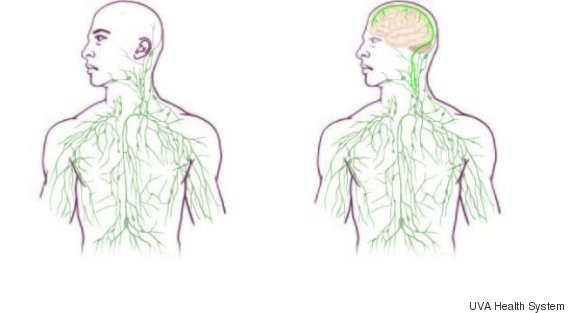Neuroscientists have uncovered a previously unknown direct connection between the brain and the immune system — a finding that could have significant implications for the treatment of brain disorders like Alzheimer’s disease, multiple sclerosis and autism.
The discovery came as a surprise to Dr. Kevin Lee, chairman of the University of Virginia’s neuroscience department.
“The first time these guys showed me the basic result, I just said one sentence: ‘They’ll have to change the textbooks,’” Lee said in a press release Monday.
The study’s lead author, Dr. Jonathan Kipnis of the University of Virginia’s Center for Brain Immunology and Glia, echoed the sentiment.
“When we discovered the lymphatic vessels we were very very surprised, because based on the textbooks — these vessels do not exist,” Kipnis said in an email to The Huffington Post.
A direct connection. While previous research held that there was no direct connection between the brain and the lymphatic system, the new findings, which were recently published in the journal Nature, present a model of the lymphatic system that includes the brain.
Though not a part of the immune system, the lymphatic system carries lymph, a clear fluid filled with white blood cells that helps remove toxins from the body. The lymphatic system is connected to every other system in the body, and was believed to end at the base of the skull.
But the researchers noticed something strange while looking through their microscopes at slides containing the membranes of mice’s brains. They saw lymphatic vessels, which had never before been observed above the base of the skull.

While the observation was made in mice, the same anatomy is believed to exist in humans as well.
New questions. A next step of the research is to determine how the vessels might be involved in diseases involving the brain and the immune system, such as multiple sclerosis and Alzheimer’s.
“We believe that for every neurological disease that has an immune component to it, these vessels may play a major role,” Kipnis said.
Though the findings are preliminary, the researchers hope they’ll open up a number of new possibilities for treating these and other neurological disorders through therapies that target the lymphatic vessels of the brain.
For example, Kipnis explained that the findings could shed light on why large protein chunks accumulate in the brains of Alzheimer’s patients. “We think they may be accumulating in the brain because they’re not being efficiently removed by these vessels,” he said.
Other members of the scientific community have expressed excitement about the discovery, while cautioning that the findings have not yet been replicated or confirmed.
“With further research, the findings could help scientists to target inflammation in the brain, which is a factor in many neurological conditions,” James Nicoll, professor of neuropathology at the University of Southampton in England, told The Guardian.


